A Week in Wales
Links golf in the land of castles
by Blaine Newnham

We were chatting with Richard Bradbury, the pro at the North Wales Golf Club, wondering from where his outside play emanated.
“From the U.K.,” he said. “And America.”
How many rounds for the Yanks last year, I asked?
“Twenty or 30,” he said.
Not 20 or 30 percent, but 20 or 30 players.
The reality is most Americans don’t even know Wales is its own country, let alone plan a golf vacation there. And so it is for us that, because of this, all its courses are the coveted hidden gems.
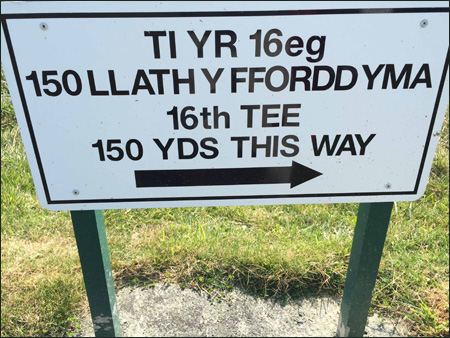
Perhaps it is because I play golf on a budget, or prefer to play the road less traveled, but what I’ve found, after two trips to Wales, are terrific and traditional links courses that are half the cost of those in Ireland and Scotland.
There may be something to boast about when you can say “been there, done that” about some of the world’s trophy clubs, but the truth is I don’t need to get beat up playing Royal Portrush a third time.
Quite directly, Wales is a much better value with less crowded courses in a charming coastal setting with more to do than much of the golf-rich, but remote, areas of Ireland and Scotland.
As I wrote after my first trip, Wales offers wonderful seaside villages, historical ruins and links golf in a land that consists of 750 miles of coastline, 641 castles, 11 million sheep and two languages.
Prior to the 2010 Ryder Cup being held on the new American-like Celtic Manor course near Cardiff in the south, I was able to play the wonderful Royal Porthcawl, easily the best course in Wales, plus Pennard, Tenby and Southerndown.
This time we started in the North, just an hour’s drive from the Manchester airport in England.
Wales is part of the United Kingdom, but like Scotland sometimes wonders if it wants to be. It convened its National Assembly in 1999, the first all-Welsh tier of government in 600 years. But big decisions still take place in London.
Day One: North Wales Golf Club
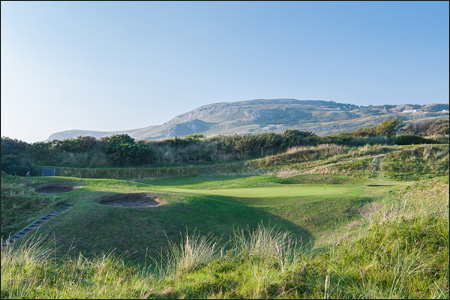
Approaching from the north, you’re drawn immediately to the authentic Victorian beach resort, Llandudno, its location under the Great Orme, a limestone rock some 680 feet high and home to, believe it or not, a tram and snow-less snowboarding.
Llandudo has a classic turn-of-the-century pier and promenade, rows of guest houses, and the revered holiday home of the real Alice in Wonderland, Alice Liddell, whose trail you can carefully follow about town.
The place bubbles with tourists. More than half the hotel beds in Wales are in Llandudno and nearby Conwy, which has its own castle, one of several a day’s march apart that King Edward I used to keep the Welsh at bay. Way back when.
In fact, we stayed in what was a five-story watchtower for Conwy castle, the
Bodysgallen Hall, restored beautifully inside and out as a donation to the National Trust.
The first round of golf in Wales was at North Wales Golf Club, where they’ve been playing the game forever, where the clubhouse is set among businesses and homes, where the local train rumbles down the left side of front-nine holes, and turning home the sea is on the left side this time. Hookers be advised.
The course was muni-like in the beginning but, like Ballybunion in Ireland, once you got out toward the sea it became a roller coaster ride, the fairways not much changed for a hundred years.
Then came the final three holes and the brilliant use of the high dunes at that corner of the land, including back-to-back par 3s over what reminded you of the Mass Hole at Waterville in Ireland.
We enjoyed the round more than I would have predicted. What we found was a good, solid golf course with all the attributes of a links course – firm fairways, tight lies, hidden bunkers, fast greens and requiring the requisite amount of imagination.
Then we met up with Bradbury, the pro who’d been at the club for a couple decades, and talked about the relative value of golf in Wales.
“It’s ridiculous, it’s crazy,” he said. “The value for the money in North Wales is great. Golf here is very undervalued. Llandudno is really fantastic as a destination.”
Day Two: Conwy Golf Club
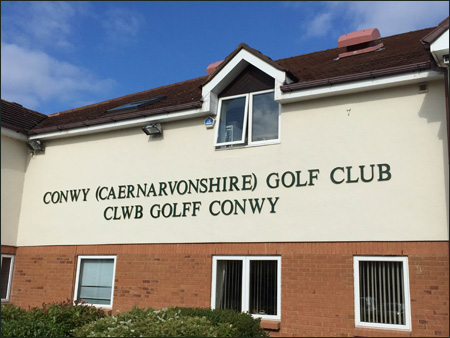
We had a tee time at Conwy for our second day in Wales, slipping in between some groups of members.
Conwy is a golfer’s course, straightforward and very firm with some complicated green complexes and a finish through the gorse that seems much narrower than it really is.
Conwy is tough enough to have hosted the final qualifier for the 2006 Open Championship, held that year at not-too-far-away Royal Liverpool, as well being the site of numerous European Senior Tour events.
What we found most interesting at Conwy was an after-the-round visit with David Williams, the club captain and, come to find out, the only golf architect in Wales.
Williams does much of his work in England, and is also a prime designer in Spain’s PGA Catalunya course, a strong candidate to host the 2022 Ryder Cup.
But his heart is in Wales, both protecting its past and promoting its future as a golf destination.
He has gone so far as to look at building a course across the top of the Great Orme, the mountain behind Llandudno, and understands the strong desire of the Welsh government to have a trophy course to perhaps someday become part of the rota for the Open Championship.
Williams co-authored a book celebrating the history of Conwy, which celebrated its 125th anniversary this year, and he produced a pamphlet describing three iconic golf paintings by Douglas Adams in 1893, paintings that many golfers have seen – “The Drive,” “A Difficult Bunker,” and “The Putting Green,” paintings that depict scenes at Conwy Golf Club, “yet nobody knows that.”
“People don’t necessarily think of Wales and golf,” Williams continued. “There are great golf courses here, but they are not well known outside Europe.”
He admits that when golfers think of the U.K. “Wales is No. 4 behind Scotland, Ireland and England.”
Golf really began at Conway in 1875 when a group of members from Royal Liverpool realized the full potential of the flat land produced by the Conwy River estuary and had a professionally-designed course laid out by their club professional, Jack Morris, nephew of Old Tom Morris.
The course was used as a military training site in World War I and nearly destroyed; it was again a military site in World War II, where prefabricated harbors, called Mulberry Harbours, were built and used in the invasion of Normandy on D-Day.
Day Three: Nefyn & District Golf Club
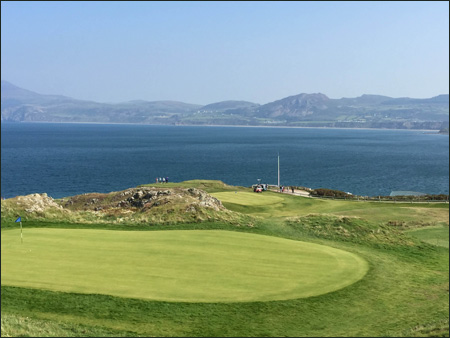
Down the coast we go in our look at North Wales golf courses, slightly more than an hour’s drive to Nefyn and its place in the very under-rated Snowdonia Golf Coast trail, as it’s called.
Besides Nefyn there are Abersoch, Porthmadog, Pwllheli and Royal St. David’s, the latter at the foot of Harlech Castle.
Playing them is easier than pronouncing them.
We won’t play Pwllheli but here is a course that piqued my interest for another trip, a layout established well over 100 years ago and designed by Old Tom Morris and James Braid.
But first there was Nefyn & District Golf Club, on a piece of property nearly the equal of Old Head in Ireland.
In fact, they boast at Nefyn of ocean views on 26 of the course’s 27 holes, one of which is so out to sea that they brag you can hit it left into the Irish Sea or right into the Irish Sea.
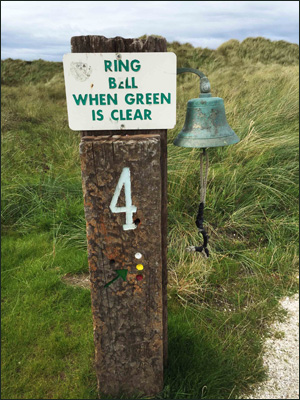
It is simply an exhilarating place to be, where the scenery is so beautiful that there are more walkers strolling the course than there are players.
Places like this are supposed to belong to the public, and not be sold to an American and locked behind closed gates as is Old Head in Ireland.
And, if the views weren’t enough, there is a picturesque pub – the Ty Coch (Red House) – right on the beach and just down the hill from the 12th green.
“Best halfway house in the world,” said an Englishman visiting Wales to play golf for the first time. Players often take a break with a few holes remaining and enjoy a tidy little harbor where the only way to get there is to walk.
A couple of holes earlier, I’d run into a group from San Diego.
“A fifth of what it costs you to play Pebble Beach and it’s got better views,” offered up the American.
Recent winter storms damaged some of the more spectacular real estate but the holes have been rebuilt and reopened.
We had another sunny day – the best week of the summer season in the U.K. – but winds built to 25 miles per hour as we neared the Coast Guard station at land’s end.
On one short par 3 at the tip of the course, we couldn’t get a ball anywhere near the green. In the wind, it took on a circus atmosphere but that’s sometimes links golf.
Most of the holes were superb, the turf firm and fast, a very enjoyable round.
The charge at Nefyn for green fees was $69 at prime time, dropping to $50 after one o’clock and $33 after three. Compare this to the rates of trophy seaside courses in the U.S.
There are those who like Nefyn for its beauty and others who think too much has been crowded into the sliver of land protruding into the Irish Sea.
It perhaps could have been the trophy course Wales has been looking for if they’d closed the place for a year and fashioned 18 holes instead of 27.
But to close the course would be to close the hiking trails the public cherishes.
Day Four: Porthmadog Golf Club
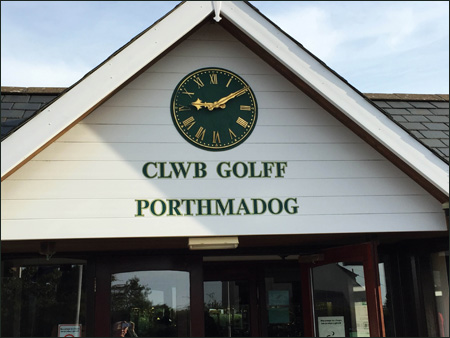
To get the real feel of golf in Northern Wales we made a visit to the “half links” of Porthmadog, a busy and beautiful little village along the Welsh coast.
Fortunately, or unfortunately, we caught strong winds – gusts up to 25 miles an hour – to help make the case that the back nine at Porthmadog is the most natural in Wales.
The design for this village course was begun by none other than James Braid, a five-time British Open champion and the architect of more than 200 courses.
Porthmadog opened in 1905, which made it among the first Braid would do.
The day we played the wind deviated from its normal direction, making the golf holes along the Irish sea more difficult than ever. One of our group, a good player, hit a driver to a 220-yard par 3 and was well short. Two holes later he hit a five-iron almost 250 yards.
None of us had ever seen a golf course with such a split personality. The front nine at Porthmadog is tree-lined, has water on four holes, and while a test, doesn’t satisfy the craving for links golf.
But while the front nine isn’t links golf, its fairways – which go unwatered – are still firm and fast, and many of the principles of the links game held.
But walk across the street at Porthmadog from the front nine to the back nine and you’re in a new world, one you don’t understand – rolling dunes obscuring views from the tee, greens cut into dunes, a par 3 whose green you can’t see from the tee.
It was wild and fun.
What we learned was never underestimate a village golf course, in its difficulty and its presentation. The greens at Porthmadog – a mix of fescue and bent grasses – produced the best putting surfaces we’d seen.
Unlike the U.S. where golf clubs value exclusivity, all the clubs in the U.K. and Ireland have a time for you to play if you can pay the tariff. Green fees can be more than $200 a round for the big-name courses. At Porthmadog they are around $50.
“We need outside play,” said Gwylim Jones, the club secretary. “It is essential. We have too many golf courses for the number of residents we have here.”
Trying to appeal to the tourist dollar, especially from England, the local clubs have banded together to form Snowdonia Golf Coast. Besides Porthmadog, there is Nefyn, Abersoch, Royal St. David’s, and Pwllheli.
The clubhouse at Porthmadog – and, really, the clubhouses we saw at all the Wales courses we visited – is cordial and comfortable.
It is apparent that in these small villages the golf club holds a certain hierarchy, it is where people who get things done do them.
The food is usually good and the drink always good. You’ve got to remove your hat when you enter the clubhouse proper, but there is never a feeling that you don’t belong.
Day Five: Royal St. David’s Golf Club
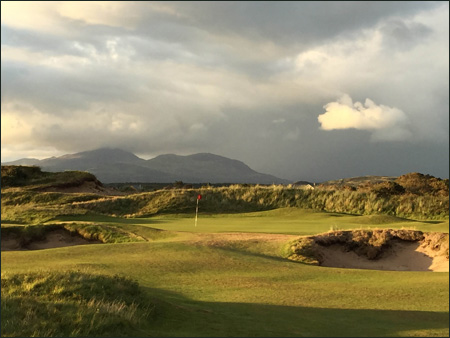
In lamenting Wales’ position in the golf world – very much obscured by Ireland and Scotland – David Williams, the only golf course architect in Wales, said that his country needed a “trophy course,” and iconic course that would draw golfers from around the world.
Sometimes you wonder what it takes to be a trophy course, and if when all is said and done and the enjoyment counted, does it matter?
Which brings us down the coast to Royal St. David’s, my idea of a perfect links course, one I could play every day, surely leaving me overmatched when the wind blew, but totally capable of keeping up, and making a few pars and really enjoying myself when it didn’t.
Royal St. David’s is also called Harlech because it sits in the shadow of famed Harlech Castle, another of a string of 13th century fortresses built by English King Edward I.
In fact, when the castle was built the Irish Sea came right to its doorstep, slapping over the lowland where the golf course is today. Epic storms in the 14th century churned up enough sand to raise enormous dunes along what is now the coastline, leaving Harlech Castle high and dry and a wonderful backdrop to the golf course.
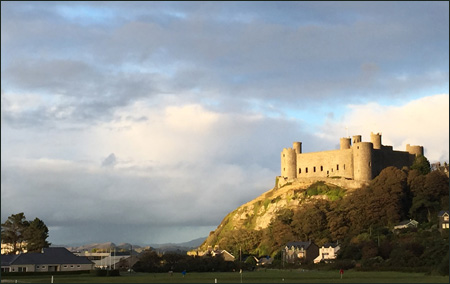
A trip up to the castle after the round, through the narrow, winding streets of a medieval village, gives you both an appreciation for your place in history and views of the golf course, the Irish Sea and the mountains of Snowdonia National Park.
While not as spectacular as nearby Nefyn, it is a better golf course, for much of the round is straightforward but finishing up in the dunes with some spectacular holes.
It is easily one of the top three courses in Wales, behind Royal Porthcawl in the south and battling Aberdovey for the second and third spots.
Royal St. David’s underscores the quality and affordability of golf in Wales. The green fees here were right at $100, when they are twice that much or more for courses of similar quality in Ireland and Scotland.
In fact, people around here compare it more than favorably with Royal Liverpool, site of British Opens, which charges $250 a round.
Harlech – what the locals call it – is a thinking man’s design, with bunkers looming in all the wrong places if you can’t keep the ball in the fairway. Or, in some cases, even if you do, with the ground as firm and fast as it is.
The par 3s – there are five of them – are particularly interesting, a couple near 200 yards, and others shorter, one with a blind shot, another with bunkers in front of the green and dunes beside it.
While most U.K. courses tend to be out and back, Royal St. David’s zigzags against the wind, one hole downwind and the next into the wind.
Part of its lack of global recognition is because it is only 6,629 from the back tees and a par of only 69. The locals will quickly tell you it’s the most difficult par 69 anywhere. When the wind is up, it might be.
Royal St. David’s has 850 members, 600 of them from somewhere else in the U.K. For $500 you can have unlimited play – when you can get there, of course.
The “Royal” designation has been given to about 60 courses around the globe, all of them in the former or present British Empire, all of them with some special relationship with royalty.
King Edward VII first deemed St. David’s a royal at the turn of the century. In the 1930s, as Prince of Wales, his brother King Edward VIII was awarded its captaincy.
We stayed in the village of Harlech, just a bump-and-run away from the castle at a place called the Castle Cottages. Although not part of the original castle, the cottages had roots in the 16th century. It calls itself a restaurant with rooms, and the food was that special, especially the rack of Welsh lamb.
Day Six: Aberdovey Golf Club
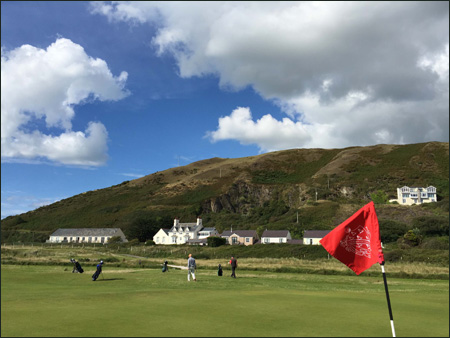
This is revered ground in Wales, where James Braid first routed the course, where Ian Woosnam is a member, and where the dean of golf writers, Bernard Darwin, said Aberdovey Golf Club was the course “his soul loved best of all the golf courses in the world.”
The drive from Harlech was about an hour, winding down the coast and at times at the foot of sheer mountainsides dotted with sheep and rock walls that seemed to end in the sky.
An equally scenic and much easier way to see this part of the world is by train, the local running every couple of hours and taking golfers from Porthmadog to Harlech and on to Aberdovey.
The train station at both Harlech and Aberdovey are a wedge shot from the respective clubhouses. The town of Aberdovey is one of the most popular vacation spots among the U.K. visitors because of its golf and its south-facing location.
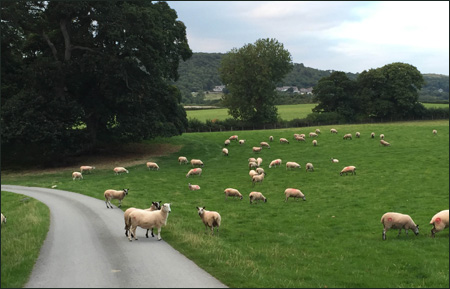
The golf course is one of the best in Wales, and in all of the U.K. for that matter. It is classic links, the first nine playing north and downwind, the second turning back into the wind.
The bunkers are unlike most of those we’ve seen in the U.K. and Ireland, festooned with tall fescue and very much visible from the tee. They reminded me of Tom Doak’s work at Pacific Dunes on the southern Oregon Coast.
The green complexes at Aberdovey were some of the best we’ve seen in Europe, the putting surfaces smooth with just the right amount of undulations.
The course has a few shots involving the dunes, including the blind iron to the 165-yard par 3 third hole. While only the tip of the flag is visible, the green is located in a basin that welcomes a good shot, and sometimes even a bad one.
The green fees at Aberdovey are $75 during prime time and less after two o’clock when the winds begin to abate and the sun begins to set in the west.
Just another reason to go to Wales, if, of course, you love spectacular views as well as spectacular golf.





